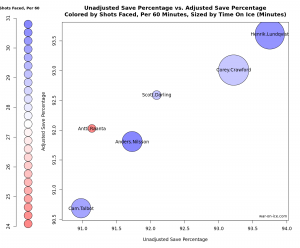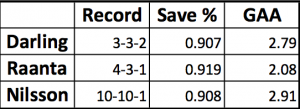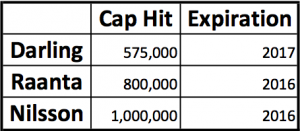Scott Darling was one of the most feel-good stories of the 2014-15 NHL season. He battled his alcohol addiction and ended up saving the Chicago Blackhawks from a first-round exit against Nashville with several heroic performances. And after a season where he posted a .936 save percentage, it seemed like an obvious choice for Chicago to re-sign him when his deal expired in the offseason.
Unfortunately for the Blackhawks though, Darling’s new contract forced the team to part with two key depth goalies within the organization: Antti Raanta and Anders Nilsson. Raanta’s frustration with his dwindling role in Chicago was well publicized, and Nilsson wanted a chance to start in the NHL after dominating the KHL in 2014-15.
However, the early struggles of Darling have made some question whether going with the unproven journeyman over more promising goalies like Raanta and Nilsson was actually a good decision. A simple number comparison of those three players doesn’t do much to disprove Darling’s doubters either:
Darling’s .907 save percentage seems to put him at the bottom of that trio, while Raanta’s impressive start and Nilsson’s rise to the top of Edmonton’s goalie ranks make them both look like better options to back up Corey Crawford.
A Closer Look
Numbers collected by war-on-ice.com paint a different picture than those basic stats shown above. During 5v5 play in 2015-16 so far, Darling actually has a better Adjusted Save Percentage than either Raanta or Nilsson. And when you look a little closer at some of the numbers found at war-on-ice, you realize that a large part of Darling’s struggles have come when his team has been shorthanded (where he has just a .765 save percentage).

This creates an interesting paradox in Darling’s performance compared to the two goalies he pushed out of Chicago this season: on one hand, he has been the best of the three at even strength (where the vast majority of time is played), yet has struggled mightily when forced to make saves with his team shorthanded.
Salary Cap Crunch
So if those three goalies are all delivering relatively similar performances, the next question to ask is what each is costing their respective teams.
As can be seen, not only is Darling the cheapest option of the three, but he also gives his team the most stability in the form of his two-year contract. The 2017 expiration date means that the Blackhawks won’t have to worry about their backup goalie position for at least the next two seasons. Meanwhile, the performances of Raanta and Nilsson could put them both in line for a raise this summer.
Additionally, the Blackhawks were able to acquire raw fringe prospects Ryan Haggerty and Liam Coughlin in the trades for Raanta and Nilsson. Neither one stands out within Chicago’s system, but Coughlin could be a valuable depth forward with size and skill if he develops to his potential while playing with the University of Vermont.
All told, Darling has given the Blackhawks more value than either Raanta or Nilsson could have provided. The fact that general manager Stan Bowman was able to gain any assets for two players that didn’t want to be in the organization anymore is just an added bonus in this situation.

